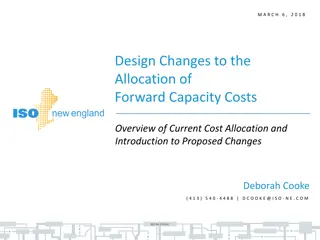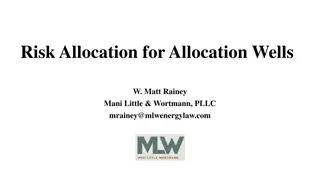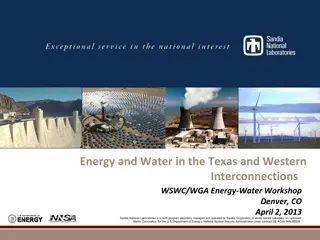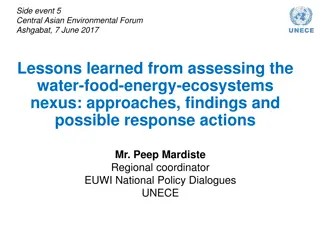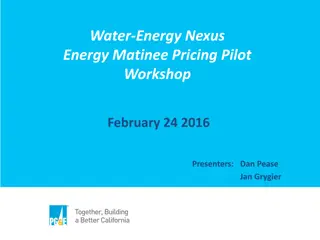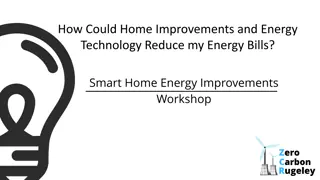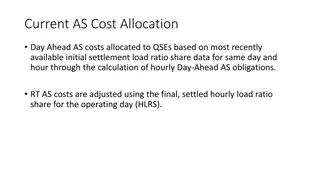Water-Energy Nexus Cost Allocation Workshop Insights
Workshop discussion focuses on proportional cost allocation among energy IOUs and water agencies based on benefits realized. Emphasis on avoiding cross-subsidies and considering strict proportionality where benefits match or exceed costs. Debate on relaxing proportionality for energy ratepayer subsidy of water-energy program costs. Insights from CPUC reports on energy efficiency progress evaluation also discussed.
Download Presentation

Please find below an Image/Link to download the presentation.
The content on the website is provided AS IS for your information and personal use only. It may not be sold, licensed, or shared on other websites without obtaining consent from the author. Download presentation by click this link. If you encounter any issues during the download, it is possible that the publisher has removed the file from their server.
E N D
Presentation Transcript
R. 13-12-011 Water-Energy Nexus Workshop on Cost Allocation May 4, 2015 Cynthia Mitchell, TURN Consultant
How should we allocate W-E program costs and savings credit? PROPORTIONALITY Costs should be allocated among energy IOUs and water agencies in proportion to the benefits realized by such partnering entities. (See slide 14 end notes re: CPUC Cost Allocation Proportionality.) The avoided cost methodology should minimize the potential for cross-subsidies from energy ratepayers to water ratepayers, from one investor owned utility ( utility or IOU ) to another utility, and from the utilities to the wholesale energy market. (TURN 9/19/2014, p. 2)
STRICT PROPORTIONALITY? Project Coordination Group (PCG) If the benefits are equal to, not exceeding, the costs then, strict proportionality may be necessary to ensure that the cost of each ratepayer group does not exceed the realized benefits, (ie. if the TRC = 1, ensuring strict proportionality is important.) If the benefits > costs (i.e. TRC > 1, then other cost allocation methods may be permissible. (emphasis added)
IS RELAXING PROPORTIONALITY APPROPRIATE? Implication of PGC Statement: Energy ratepayers can subsidize water-energy program costs in excess of site and embedded energy benefits, that is, up to a TRC of 1.0. The current EE portfolios are marginally cost-effective, with significant non incentive program and non-resource program costs. Also, there is already significant competition for EE program funding especially in light of recent legislative mandates. There is little if any head room in the EE portfolios for supporting water efficiency programs even if the forecasted embedded energy benefits appear to exceed the projected energy-only costs. The standard adopted in Decision 07-12-050 should be applied in this proceeding. (TURN 9/19/2014, p. 8)
CPUC 2010 2012 Energy Efficiency Annual Progress Evaluation Report March 2015
CPUC 2010 2012 Energy Efficiency Annual Progress Evaluation Report March 2015 IOU Reported Gross 9,167 GWh ED Evaluated Net Difference 4,923 GWh, TRC 1.04 4,244 GWh, or 54% Evaluation activities reviewed approximately 75 % of claimed savings, that is, 25% of claimed savings passed through.
See slide 14 end notes re: Market vs Economic EE Potential. See slide 15 end notes re: Market-based Business-As-Usual EE Portfolios
What factors should be considered in determining cost allocations? First, IOU site energy and embedded energy saving benefits. Second, water capacity and waste water capacity saving benefits.
Does the cost effectiveness model provide sufficient information to support anticipated cost allocation processes? - No, the model cannot readily evaluate proportionality. Does not include site energy saving benefits; only embedded energy saving benefits. Does not allow consideration of cost effectiveness from an IOU energy ratepayer perspective, that is, based on the energy savings benefits. Remedies Include embedded energy benefits in the existing E3 calculator. This would provide a transparent analysis of water-energy program benefits from an energy IOU ratepayer perspective. And / or, expand the Navigant water-energy calculator to include site energy saving benefits, and run the calculator in two steps: 1. First with IOU site and embedded energy saving benefits, 2. Then with water capacity and waste water capacity benefits.
Columns 2, 3, 4: Cost elements h.e. toilet $425.00. Column 8: NPV IOU embedded energy benefits, $76.01. Columns 9 & 10: NPV water capacity and waste water capacity benefits, $90.11 and $628.27 Columns 8, 9, & 10: NPV benefits combined: $794.39 Column 11: Combined TRC: 2.14.
TURN Recommended Approach for Transparent Cost Allocation Wtr-Energy IOU Site IOU Embedded Total IOU TRC Water Waste-Water Total TRC Measure/Program Energy Savings Energy Savings Energy Energy Capacity Capacity Water Energy & Water Cost Benefits Benefits Benefits Ratepayers Benefits Benefits Benefits Ratepayers From slide 9 Remedies : Expand the Navigant water-energy calculator to include site energy saving benefits, and run the calculator in two steps: First with IOU site and embedded energy saving benefits, Then with water capacity and waste water capacity benefits.
Closing Thoughts Use energy ratepayer funds to save as much energy in water usage as cost-effectively possible. Go after large system leaks saves more water and energy for a lot less money, and increases water system pumping and efficiency. Re-double efforts in agriculture, municipal and wastewater treatment facilities (EE-iDSM approach). Ex: recovering gas off of waste water systems and use that gas to generate electricity. IOUs could help water agencies with infrastructure costs. Lowering agriculture and water agencies energy costs will free up precious funds for water saving activities. And certainly, keep at the water-energy nexus rulemaking. Develop better embedded energy values. Using averages now.
End Notes re. CPUC Cost Allocation Proportionality Decision 07-12-050, authorizing Wtr-Energy Studies and directing IOUs to run pilot programs. FoF 5: While it is important to understand all of the savings resulting from a given initiative, those savings may provide little comfort to utility customers who are paying for a water conservation effort, but not seeing a direct benefit in the form of reduced energy use in their own service territory. Commissioner Sandoval Dissent to the Decision in A.10-11-009 September 10, 2014. SCE application to increase electric rates by about $9 million to pay for a portion of the Catalina water system. There is no nexus between the electric ratepayers and the Catalina Island water system It is anathema to the federal and state constitutions and the CPUC code to adopt a settlement that violates the due process rights of SCE electric ratepayers simply because the majority believes it provides a policy solution for a separate high cost water system.
Market vs Economic EE Potential Market or Business as Usual: Encourage and promote customer EE investments. Consumers willing and able to make EE capital investments based on 10 - 20+ year paybacks. McKinsey 2009: Consumers very short payback requirements. Residential 2-3 yr; Commercial 3.6 yr; Industrial 18 mo 3 yr. Largely mass market , statistical function integrated across thousands of discrete and dispersed efficiency measures. Estimation of savings. Economic: Supply side avoided cost analysis 20+ years. Large capital markets with returns on investments matched to energy value provided via G,T,D infrastructure investments over time. Efficiency bundled with DR, ES, solar, DG as DER. Location and site specific, significant load and energy reductions / management. Metered load reductions.
Current IOU Market-based Business-as- Usual EE Portfolios 2,000+ GWh EE savings annually. Cumulative? EE savings less than incremental load growth One-third CFLs, T-8s One-third C&S savings assuming high compliance rates Free ridership (NTG) approximately 50% Cost-effectiveness (TRC) around 1.0 200+ Programs






